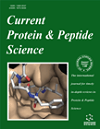- Home
- A-Z Publications
- Current Protein and Peptide Science
- Previous Issues
- Volume 24, Issue 1, 2023
Current Protein and Peptide Science - Volume 24, Issue 1, 2023
Volume 24, Issue 1, 2023
-
-
A Perspective on the Impact of Advanced Glycation End Products in the Progression of Diabetic Nephropathy
More LessAuthors: Afreen Khanam, Saheem Ahmad and Arbab HusainIn 2007, diabetes affected around 244 million people across the globe. The number of diabetics worldwide is projected to reach 370 million by 2030. With diabetes incidence reaching epidemic proportions globally, diabetic nephropathy (DN) has emerged as one of the most difficult health conditions. Although therapeutic approaches such as rigorous blood glucose and blood pressure management are successful in preventi Read More
-
-
-
Polyaromatic Hydrocarbon Specific Ring Hydroxylating Dioxygenases: Diversity, Structure, Function, and Protein Engineering
More LessPolycyclic aromatic hydrocarbons (PAHs) are ubiquitously present in the environment. These compounds have demonstrated both mutagenic and carcinogenic properties. In the past few decades, scientists have constantly been looking for a possible route to their biological degradation. Bacterial ring hydroxylating dioxygenases (RHDs) implicated in the polycyclic aromatic hydrocarbon degradation comprise a large family Read More
-
-
-
Epigenetic Regulator ASXL2: Structure, Function and its Predictive Value in Diseases
More LessAuthors: Mengru Li, Lijun Xu, Rui Zhang and Chunming DongASXL2, as a transcription regulator, is a research hotspot for tumor detection. The aberrant expression of ASXL2 protein has been mainly implicated in malignant hematological and heart diseases. To further explore the predictive value of ASXL2 in diseases, we reviewed the structure and function of ASXL2 protein, the post-translational modification mechanism, and the expression of ASXL2 protein in the pathogenesis Read More
-
-
-
Anti-Platelet Peptides Targeting αIIbβ3 Outside-In Signaling Pathway
More LessAuthors: Jialing Wang and Xin XuPlatelets and their progenitors express high levels of integrin αIIbβ3, which plays a key role in platelet functions, hemostasis, and arterial thrombosis. Because of their quick and high efficacy, the three anti-αIIbβ3 drugs, abciximab, eptifibatide, and tirofiban, are regarded as potent anti-thrombotics and clinically approved by US Food and Drug Administration. However, because they interfere with the inside-out signal Read More
-
-
-
Ubiquitous Existence of Cation-Proton Antiporter and its Structurefunction Interplay: A Clinical Prospect
More LessAuthors: Manish Dwivedi and Sowdhamini MahendiranSodium, potassium, and protons are the most important ions for life on earth, and their homeostasis is crucially needed for the survival of cells. The biological cells have developed a system that regulates and maintains the integrity of the cells by facilitating the exchange of these ions. These systems include the specific type of ion transporter membrane proteins such as cation-proton antiporters. Cation proton antiporters ind Read More
-
-
-
Peptide Triazole Inhibitors of HIV-1: Hijackers of Env Metastability
More LessAuthors: Erik P. Carter, Charles G. Ang and Irwin M. ChaikenWith 1.5 million new infections and 690,000 AIDS-related deaths globally each year, HIV- 1 remains a pathogen of significant public health concern. Although a wide array of effective antiretroviral drugs have been discovered, these largely target intracellular stages of the viral infectious cycle, and inhibitors that act at or before the point of viral entry still require further advancement. A unique class of HIV-1 entry inhibitors, call Read More
-
-
-
Thymosin β4 and Actin: Binding Modes, Biological Functions and Clinical Applications
More LessAuthors: Yuyuan Ying, Chen Lin, Nana Tao, Robert D. Hoffman, Dongling Shi, Zhijin Chen and Jianli GaoThymosin β4 (Tβ4) is the β-thymosin (Tβs) with the highest expression level in human cells; it makes up roughly 70-80% of all Tβs in the human body. Combining the mechanism and activity studies of Tβ4 in recent years, we provide an overview of the subtle molecular mechanism, pharmacological action, and clinical applications of Tβ4. As a G-actin isolator, Tβ4 inhibits the polymerization of G-actin by binding to the Read More
-
-
-
Potential of Angiotensin-(1-7) in COVID-19 Treatment
More LessThe new coronavirus currently named SARS-CoV-2 was announced by the World Health Organization as the virus causing the COVID-19 pandemic. The pathogenesis of SARS-CoV-2 initiates upon contact of a structural spike protein with the angiotensin II-converting enzyme receptor, leading to the induction of inflammatory mechanisms and progression to severe disease in some cases. Currently, studies have emerged linking C Read More
-
-
-
Ragweed is in the Air: Ambrosia L. (Asteraceae) and Pollen Allergens in a Changing World
More LessAuthors: Chiara Montagnani, Rodolfo Gentili and Sandra CitterioGlobally Ambrosia species (Asteraceae), commonly called ragweed, are recognized to be one of the most problematic groups of invasive weeds and one of the main allergenic genus. Climate and land-use change and air pollution are expected to promote ragweed spread, increase airborne ragweed pollen concentrations (the source of allergens), extend the pollen season, and promote longdistance transport of pollen or sub- Read More
-
Volumes & issues
-
Volume 26 (2025)
-
Volume 25 (2024)
-
Volume 24 (2023)
-
Volume 23 (2022)
-
Volume 22 (2021)
-
Volume 21 (2020)
-
Volume 20 (2019)
-
Volume 19 (2018)
-
Volume 18 (2017)
-
Volume 17 (2016)
-
Volume 16 (2015)
-
Volume 15 (2014)
-
Volume 14 (2013)
-
Volume 13 (2012)
-
Volume 12 (2011)
-
Volume 11 (2010)
-
Volume 10 (2009)
-
Volume 9 (2008)
-
Volume 8 (2007)
-
Volume 7 (2006)
-
Volume 6 (2005)
-
Volume 5 (2004)
-
Volume 4 (2003)
-
Volume 3 (2002)
-
Volume 2 (2001)
-
Volume 1 (2000)
Most Read This Month
Article
content/journals/cpps
Journal
10
5
false
en


